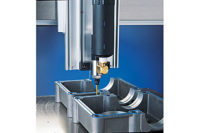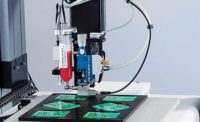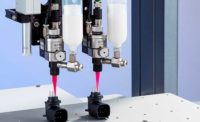The valves use low-volume, low-pressure (LVLP) technology to cleanly apply a wide range of materials. Manufacturers have used the valves to apply adhesive activators on automotive trim, marking inks on circuit boards, reagents on medical test strips, grease on door handle springs, and coatings inside bores and bushings.
Coating System Components
An LVLP coating system consists of an LVLP precision spray valve, a microprocessor-based valve controller, and a pressurized fluid reservoir (tank or disposable cartridge).
The LVLP spray valve features an air-actuated needle design with separate air inputs for valve actuation and fluid atomization. Because the valve has a low fluid-flow rate, very low air pressure is needed to produce a soft spray of material.
The valve delivers high transfer efficiency (the percentage of solids that end up on the workpiece) with negligible overspray or mist. Various spray patterns can be produced by changing the valve nozzle and air cap.
The valve controller connects to the plant air supply and is used to adjust nozzle air pressure for different assembly fluids and viscosities. During operation, actuating air from the controller lifts a piston that retracts the stainless steel needle from the nozzle seat and allows fluid to reach the nozzle.
At the same time, nozzle air (typically 1 to 3 psi) flows around the nozzle to create a pressure drop that causes the fluid to break into fine droplets that apply cleanly.
When the actuating air is shut off, the needle moves down into the nozzle seat to stop the flow of fluid, while the nozzle air continues for a split second. This momentary delay in shutting off the nozzle air removes any residual material from the nozzle and minimizes the risk of clogging at the end of the spray cycle.
The amount of material applied is determined by adjusting fluid pressure, valve stroke and valve open time. The valve controller can adjust valve open time in increments as small as 0.001 second. It can be activated mechanically or interfaced with a PLC, and can apply fluid either at specified intervals or whenever a particular signal is received.
In addition, the controller can significantly reduce setup time by allowing fluid feed lines to be purged, spray volumes set, and adjustments made and observed at the point of application—all without stopping the production line.
Reservoir capacity ranges from 2.5 ounces to 19 liters, depending on the fluid and application. Fluid is supplied to the valve from the reservoir tank or disposable cartridge, both of which are equipped with a constant-bleed regulator that maintains consistent pressure on the material. Two regulator options (0 to 15 psi and 0 to 100 psi) enable the spray valve to handle different fluid viscosities.
Match Valves to Applications
Several LVLP valve designs are available to meet both general and specific application requirements.
The standard LVLP spray valve is suitable for most applications. It can produce round patterns from 0.17 to 2 inches and fan patterns up to 6.5 inches wide.
MicroSpray is an innovative valve with a small gauge (0.013- to 0.004-inch internal diameter) disposable dispensing tip rather than a standard spray nozzle. Seating the valve needle in the hub of the dispensing tip places the fluid cutoff point closer to the workpiece and ensures precise shot size. The MicroSpray valve also concentrates the LVLP air so that the material can be applied in uniform patterns as small as 0.13 inch in diameter.
The Aseptic spray valve is a special-purpose valve for demanding medical device and biopharmaceutical applications. Like the MicroSpray, the aseptic valve has a small gauge disposable tip rather than a standard nozzle. To keep fluid sterile, it has a smooth fluid-flow path that is free of entrapment areas. The valve’s wetted parts are made of 316L stainless steel and Teflon, making the valve suitable for both clean-in-place and sterilize-in-place processes.
Another special-purpose valve is the radial spray valve, which is used to apply material inside cylinders like engine bores and bushings. This valve atomizes fluid with low-volume low-pressure air and uses a precision air motor to drive a rotating air cap. The valve’s 2.2-inch-long rotor can reach inside cylinders with a minimum inner diameter of 1 inch. Material flow is instantly cut off at the end of the spray cycle.
LVLP valve marking systems are used to mark parts with colored inks or stains. These markings differentiate similar-looking components, indicate pass-fail status, or confirm whether a specific process has been performed.
The systems produce round patterns or stripes from 0.2 to 1.2 inches wide. They require no maintenance, eliminating downtime needed to change contaminated or dried-out pads on contact marking systems.
Also, because LVLP valves operate at lower pressures and flow rates than standard spray systems, they can use a longer valve stroke. This leaves more space around the valve needle and greatly reduces the possibility of pigment building up to the point where it eventually blocks the valve nozzle.
LVLP valve marking systems are also available in a recirculating configuration for use with heavily pigmented marking fluids that need to be kept in suspension. A motor-driven gear pump pulls fluid from the reservoir and supplies it to the double-ported spray valve, where it enters one side of the fluid head and exits from the other.
As the marking fluid is returned to the reservoir, it produces a slight agitation that keeps the pigment from settling at the bottom of the tank. As little as 1 psi can be sufficient to keep the fluid in constant recirculation.






